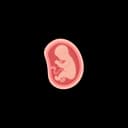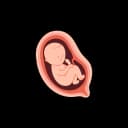Your Pregnancy at Week 42
Getty Images

Written by Mindsmaking Medical Writer
Fact Checked by Mindsmaking Professionals
27th, July, 2025
At 42 weeks pregnant, you're in the final stretch of a long journey. Your baby is fully developed and ready to meet you, but sometimes, they need a little extra time before making their grand entrance.
At 42 weeks pregnant, you've reached the last week of your pregnancy journey. The anticipation of meeting your baby is likely at its peak, and you may feel a mix of happiness, nervousness, and anxiety. These feelings are normal as you prepare for the moment you've been waiting for, holding your baby in your arms for the first time. You've probably imagined countless times what it will be like to finally see and touch your baby's tiny hands and feet. Rest assured that you're just days away from meeting your little one face-to-face.
Key Takeaways
At 42 weeks, your baby is likely in a head-down position, nestled in your pelvis and ready for birth. However, the comfort of the womb might delay the onset of labour.
Your baby measures around 20.4 inches and weighs about 3674 grams, comparable to a watermelon.
At 42 weeks pregnant, there's a strong chance that labour will start naturally. However, if the baby isn't born by the end of this week, the risk of complications increases.
You may experience more frequent Braxton Hicks contractions, which are irregular and less intense "practice" contractions. If these contractions become more regular and intense, it could signify that labour is starting.
If you choose to exercise, be aware of warning signs that require you to stop immediately. These include shortness of breath, dizziness, chest pain, leaking amniotic fluid and regular painful contractions.
Sitting or gently bouncing on a birthing ball can improve blood flow to the pelvis and aid in cervical dilation.
Helping your partner find ways to relax and stay comfortable can make the waiting period more bearable for her.
Communicating with your care team to let them know how you're feeling and your plans for labour and delivery will help them adjust their plans as needed.
Take a peek

Increased Weight
By 42 weeks, your baby is fully developed and ready to be born. Due to the additional time in the womb, it will likely weigh more than babies born at full term (around 40 weeks).

Wrinkled, Dry, or Cracked Skin
Overdue babies may have wrinkled, dry, or cracked skin because the protective vernix has been shed weeks before. Once your baby starts feeding regularly, their skin will gradually return to normal.

Longer Nails and Hair
Your baby will have longer fingernails, toenails, and hair than babies born on time.
Baby Development at Week 42
At 42 weeks pregnant, Your baby is likely in a head-down position, snugly tucked into your pelvis, ready for birth, but the comfort of the womb might be causing a delay in the onset of labour. Your baby is fully developed and ready to be born, though they may be larger than if they had arrived earlier, simply because they've had extra time to grow. However, due to the limited space in your uterus, their weight gain may have slowed, though they're still putting on a bit each day.
When babies are born past their due date, they might have a slightly different appearance than those born on time. Their skin may look a bit wrinkled, dry, or even cracked. This is because the protective vernix that once covered their skin was shed weeks ago as they were getting ready for their original due date, which now feels like ages ago. But don't be concerned, their skin will soon return to normal once they begin feeding regularly.
You might also notice that their fingernails and toenails are quite long, their hair is longer, and they won't have the fine, downy hair called lanugo. Additionally, some babies pass meconium (their first poo) while still in the womb, which can give their skin a slight greenish tint. Again, this is nothing to worry about, it will fade away within a few days after birth.
Mindsmaking

Body Changes at Week 42
At 42 weeks pregnant, there's a strong possibility that labour will begin naturally. However, if your baby hasn't been born by the end of this week, the likelihood of complications can rise. As the pregnancy extends beyond 42 weeks, the placenta, which plays a crucial role in nourishing your baby, may start to deteriorate, increasing the risks such as stillbirth. (2)
Given these potential dangers, discussing the option of labour induction with your healthcare provider is important. The primary concern in these discussions should be the safety and well-being of your unborn baby.
If you're eager to encourage labour naturally, there are several things you can try, though it's essential to consult your doctor before attempting any of them. One method is gently rubbing your nipples, which can stimulate the hormone oxytocin and potentially trigger labour contractions. Some people also believe that having sex can help start labour, as the act itself might trigger contractions, and the prostaglandins in your partner's semen could help soften and prepare the cervix.
As you approach labour, you may notice an increase in Braxton Hicks contractions. These are practice contractions that your body uses to prepare for the real thing. If these contractions become more regular and frequent, it could be a sign that true labour is starting. A loose stool and some abdominal discomfort might also indicate that labour is imminent.
Even at 42 weeks, your appetite might remain strong, though the size of your baby could make it difficult to eat large meals. It's wise to adjust your eating habits by consuming smaller, more nutritionally dense foods to manage this. You may feel hungry as labour approaches, but avoiding sugary snacks, which provide only a short burst of energy, is better. Instead, choose carbohydrates like bread or plain pasta, which break down more slowly, providing sustained energy. Avoid fatty foods, as they could cause nausea, especially during the stress of labour.
Read This Next
No posts available
Pregnancy Symptoms at Week 42

Oedema
At this stage of pregnancy, the high volume of bodily fluids and the difficulty in moving around often lead to swelling in your feet and ankles, a condition known as oedema. Although it might seem counter-intuitive, drinking plenty of fluids can help reduce swelling. Additionally, elevating your feet while lying or sitting can help prevent fluids from pooling in your ankles and feet, providing some relief from the swelling.

Braxton Hicks contractions
At this point, you may experience more frequent Braxton Hicks contractions, which are often referred to as "practice" contractions. These contractions cause your uterus to feel tight or hard and are your body's way of preparing for labour. Unlike true labour contractions, Braxton Hicks are usually irregular and not as intense. However, if you start noticing a regular pattern in these contractions, with them becoming more consistent and possibly stronger, it could be a sign that labour is beginning.

Insomnia
As you eagerly anticipate the arrival of your baby or the scheduled time for induction, it's natural to feel anxious and find yourself counting down the hours. However, this anticipation can make sleeping difficult or maintaining a positive mood difficult. To help manage these feelings, try to relax by practising breathing techniques, which can calm your mind and body. You might also find it helpful to distract yourself by reading a book or soothing your aches and pains with a warm bath. These simple activities can create a more peaceful environment and improve your well-being during this waiting period.

Leaky breast
As you approach the end of your pregnancy, it's common to start leaking colostrum from your nipples. Colostrum is a thin, yellowish fluid that precedes the production of mature breast milk. If you find this leaking uncomfortable or inconvenient, nursing pads in your bra can help manage any moisture and keep you feeling dry.

Water breaking
If you notice a sudden gush or a steady trickle of clear, odourless fluid, it likely means that your amniotic sac has ruptured, causing amniotic fluid to leak out. It's important to inform your healthcare provider about this and follow their instructions regarding labour and delivery. While only about 5 percent of women experience their water breaking before labour starts, it could indicate that you are close to giving birth.
Pregnancy Concerns at Week 42
It's important to discuss any plans to induce labour through exercise with your healthcare provider, particularly if you have a high-risk pregnancy. Your provider can guide you on what's safe and what to avoid based on your circumstances.
If you decide to proceed with exercise, you should be mindful of certain symptoms that signal you need to stop immediately. These include shortness of breath, dizziness, chest pain, headache, vaginal bleeding, leaking amniotic fluid, abdominal pain, regular painful contractions, and pain or swelling in your calf. Experiencing any of these symptoms could indicate a problem, and you should contact your healthcare provider immediately if they occur.
Health Tips for Pregnancy Week 42
Eat healthy
Maintain a healthy diet with nutrient-rich foods to prevent bloating and constipation. Pineapple is a great choice, as it contains bromelain, which can help soften the connective tissues in your muscles. Including salmon and sardines in your diet, but no more than twice a week, is also beneficial, as they are rich in DHA, which can boost the DHA levels in your breast milk. It's best to avoid unhealthy junk food and opt for fresh fruits like apples and kiwis instead.
Sit or bounce on a birthing ball
Sitting or gently bouncing on a birthing ball can be a helpful practice during late pregnancy. Sitting on the ball with your legs apart in a neutral, wide-legged position can promote increased blood flow to your pelvis and help open it up. This can encourage the baby to move down into the birth canal, potentially speeding up cervical dilation, which is an important step in the labour process. However, it's important to avoid falling while using the birthing ball. Make sure you're stable and comfortable, and consider having someone nearby to help you maintain balance if needed.
Take time to relax as much as possible
If you're feeling stressed about the duration of your pregnancy and the symptoms associated with being 42 weeks pregnant, it's important to find ways to relax. Practices such as prenatal yoga or meditation can help calm your mind and reduce anxiety. Additionally, a soothing scalp massage from your partner can be a comforting way to unwind. Taking deep, slow breaths can also help you relax and mentally prepare for labour.
Stay active
Low-impact exercises during pregnancy are usually beneficial unless your healthcare provider advises otherwise. Walking, in particular, can be very helpful as it encourages cervical dilation and helps your baby move lower into your pelvis, preparing your body for labour.
Pamper yourself
At 42 weeks pregnant, you're likely feeling physically and emotionally exhausted as you wait for your baby's arrival. It's important to take care of yourself during this time, so why not treat yourself to a bit of self-care? Whether it's taking a nap in the middle of the day, buying a new bag in a colour that makes you feel good, or indulging in a favourite treat like a scoop of ice cream, permitting yourself to enjoy these small pleasures can be a comforting way to lift your spirits. After all, you deserve some pampering for all the hard work your body is doing.
Advice for Partners
- Your partner may be feeling anxious or frustrated about still being pregnant. Offer her reassurance and keep a positive attitude. Remind her that the baby will arrive soon, and she's doing an amazing job.
- Be patient with her moods and needs, and try to understand what she's going through. Listen to her concerns and offer comfort without trying to "fix" everything.
- Offer to help with household chores, meal preparation, or anything else that might be physically demanding for her right now. Small acts of service can make a big difference.
- Help her find ways to relax and stay comfortable through prenatal yoga, meditation, a gentle massage, or simply taking walks together. Being calm and relaxed can make the waiting period more bearable.
Pregnancy Checklist for Week 42
- You likely packed your hospital bag a few weeks ago, so double-checking it to ensure you have everything you need might be a good idea.
- Consider communicating with your care team to let them know how you're feeling and your labour and delivery plans. Keeping them in the loop will help them adjust their plans as needed.
- Stock your refrigerator and kitchen shelves with healthy, easy-to-prepare foods to pass the time. Once the baby is home, you'll have limited time for shopping and cooking.
- Read up on what to expect during the first week after birth, including waiting for your milk to come in, soft spots and peeling skin on your baby (both of which are normal), postpartum recovery, and giving your baby their first baths.
Frequently Asked Questions
How big is my baby at week 42?
Your baby is about the size of a watermelon. Even though she hasn't arrived yet, rest assured that she's safe and still developing inside your tummy.
Is it common to be 42 weeks pregnant?
Each pregnancy is unique, which makes it difficult to predict the exact timing of when you'll give birth. You do not need to be overly concerned if you've passed your due date. Only about 5% of babies are born on their assigned due date. Data from births in the United States in 2017 showed that 0.33% of babies were born as late as week 42. While it might feel unusual to go beyond your due date, it's not uncommon, and most babies arrive safely, even if they're a bit late.
Why am I still pregnant at 42 weeks?
You might still be pregnant at week 42 (overdue) for several reasons. One common cause is an incorrectly calculated due date, which can happen if you're unsure of the exact date of your last period or if your menstrual cycles are irregular. In such cases, you may not be as far along in your pregnancy as you think. Other factors that could contribute to an overdue pregnancy include having experienced a previous overdue pregnancy, being overweight, or if this is your first time having a baby. These factors can influence the timing of labour, potentially leading to a longer pregnancy.
Will my baby be larger if born at 42 weeks compared to other babies born at full term?
Although it's not certain that your baby will be large just because you're overdue, one of the risks of late or post-term pregnancies is that your baby might be bigger. This is because your baby continues to grow while remaining in the uterus beyond the typical due date. The longer they stay in the womb, the more time they have to gain weight and size, potentially leading to a larger baby at birth.
Can any method help my water break at home at 42 weeks?
If you're 42 weeks pregnant and haven't started labour yet, it's understandable to feel concerned. However, before trying any natural methods to induce labour, it's crucial to consult your doctor. Some commonly suggested methods include having sex, taking long walks, and doing exercises such as deep squats and lunges. These activities may help stimulate labour, but getting medical advice first is important to ensure they are safe for your specific situation.
Was this article helpful?
How many stars are you giving this article?
Leave a comment
Your email address will not be published.










































